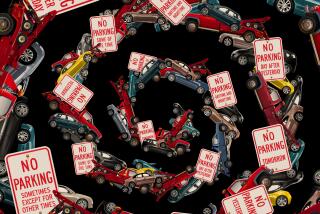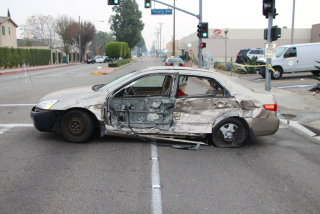Rude Roads
Los Angeles Traffic Commissioner Beverly Mosley had heard the stories about freeway road rage, listened to disturbing courtroom testimony involving drivers who lost their cool and became menacing predators.
But nothing prepared her to witness that anger firsthand.
It happened during an afternoon trip along the Harbor Freeway south of downtown when an irate driver pointed a gun in her face.
Mosley was a passenger in a friend’s car, heading home toward Carson--apparently moving too slowly for the motorist who suddenly had appeared in their rearview mirror. The driver flashed his high beams. When Mosley’s friend failed to give way, the other driver lurched out of his lane and pulled up alongside.
“I looked over and saw this man with a weapon pointed at me,” Mosley recalls several years later. “I said, ‘Oh my God, he’s got a gun!’ It never entered my mind that he would actually shoot the thing, but I’ll never forget that look of outrage on his face.”
While her friend slowed to let the man pass, Mosley used her cell phone to report the driver. But she was unable to give his license number, and the motorist was never arrested.
For Mosley, a traffic commissioner for 11 years, it was a raw reminder of the Los Angeles she sees in her court: a nervous, jumpy place where people too often take things personally behind the wheel.
Road disagreements have gotten meaner, drivers are more stressful and mistakes are more costly than in 1946, when Times reporter Gene Sherman examined what his editor described as “the blundering herd in our streets” by taking a midday ride in the passenger seat with a traffic judge:
Municipal Judge William M. Byrne’s “court” was his sedan in which we were driving toward Westwood along Beverly Boulevard. The “defendants” were the drivers of the other cars on the street.
The judge called the court to order and quickly arrived at a verdict: “Guilty.”
“Guilty of what, Your Honor?” I asked.
“Selfishness,” His Honor replied. “People may be good fathers and good mothers and sterling generous citizens in their homes and offices, but when they get behind a steering wheel they turn selfish. They lose all respect for the rights of others.”
Just then, a car angled ahead of Byrne, claiming its prize: the first spot in line at a traffic light.
“Look,” said the judge, mentally sentencing the driver to 30 days at hard observance of others’ rights, with time off for generosity, “he just can’t resist cheating a little.
“Everybody tries to get the best of everyone else on the streets. It turns into a vicious circle, with drivers resentful of treatment by other drivers taking it out, in turn, on still others.”
Judge Byrne didn’t think drivers in ’46 were purposely malicious, merely careless, their faux pas committed without thinking. And although Commissioner Mosley presides in a decidedly more dangerous era, she agrees.
“I prefer not to think of people as malicious,” she said. “Drivers are sometimes not as alert as they could be, they’re often distracted and not always courteous. But thank God the malicious drivers are few and far between.”
Mosley, 50, is a native of Nebraska, a mostly rural land of two-lane roads and the occasional interstate highway. She moved to Los Angeles in 1970 and took a job as a schoolteacher in Watts, falling in love with the breezy sway of the palm trees here. But even back then, she was keenly wary of the city’s hurry-up-to-get-there drivers.
She eventually attended law school, and after several years of private practice and working for the city attorney’s office was hired in 1987 as a traffic commissioner--a post with essentially the same legal powers as a judge.
Nowadays, the grandmother and mother of two drives a new Lincoln Navigator, a behemoth of a vehicle that allows her an elevated and commanding view of the road. She dismisses talk that sport utility vehicle owners like her are arrogant road hogs, saying she is more careful than ever, knowing that her lumbering vehicle would destroy many smaller cars on impact.
She heads west on Washington Boulevard out of downtown, slowing for a beat-up baby blue pickup truck that pulls out ahead of her. If the driver had waited for just two more cars, she says, shaking her head, his path would have been clear and he would not have had to cut anyone off.
Moments later, a red sports car swoops out of the right lane, sandwiching itself between Mosley and the car ahead. “Now, those are the drivers I don’t understand,” she says.
The sports car is stopped at the next traffic light, with a now-miffed traffic commissioner right behind. “You can’t keep a safe distance between yourself and the car ahead of you--not in L.A., people won’t allow that,” she says.
In her years on the bench, Mosley has heard tens of thousands of traffic cases--sometimes more than 300 a day. The defendants who irk her the most are the ones who follow other motorists too closely, make unsafe lane changes and barrel past pedestrians.
Then there are the slow drivers who often cause as many accidents as the fast ones. The mothers who claim some suburban entitlement to double park while dropping off the kiddies at elementary school. The ones who selfishly fail to yield to emergency vehicles or cut off fire trucks to save a few seconds on a milk run to the corner store.
And the ones who try to outrun trains at crossings. “I get so exasperated. I inform them of the fine and then tell them that I’m glad they survived their little stunt and are still around that I can impose it.”
Now Mosley is westbound on the Santa Monica Freeway, prime breeding ground for the thoughtless driver. Freeways, she says (while chastising her passenger for not wearing his seat belt) are the place where people most often flout the law.
As a case in point, she points out a motorist in a racy subcompact who blows past, doing nearly 100 mph.
On the bench, she has little patience for such offenders, many of whom will admit they may have been breaking the speed limit but claim they were going with the flow of traffic. If traffic is going that fast, Mosley explains, somebody deserved to get a ticket, and that somebody, unfortunately, is you.
She rolls her eyes over motorists who zigzag in and out of the car pool lane, who cross the double-yellow lines, who make wild, last-minute arcs across six lanes of traffic just to make an exit they’re afraid to miss.
“Usually, that person gets away with their little move and everyone else bunches up and smashes behind them. Trouble is, people don’t think they should be inconvenienced behind the wheel. If this is their exit, then this is their exit, it doesn’t matter who’s behind them.”
Her solution to such bad driving habits is simple: Make driver education classes--once part of high school curriculum but long eliminated by cuts in education funding--mandatory for young people and provide them free, if necessary.
Mosley’s best advice for dealing with road-raged drivers is to make sure you don’t encourage them: Don’t honk your horn, don’t shake your fist, don’t even look over in their direction.
She remains baffled by the syndrome.
“I don’t know who these people are, whether they’re just everyday folks who suddenly snap or drivers who are prone to this sort of emotional breakdown. I just don’t want to run into one of them ever again. And I feel sorry for anyone else who does.”
With that, the commissioner pulls into her office parking spot and shuts off her engine. Traffic court adjourned.
*
Read the stories from Gene Sherman’s 1946 series on The Times’ World Wide Web site. Go to: http://161.35.110.226/driving.
More to Read
Sign up for Essential California
The most important California stories and recommendations in your inbox every morning.
You may occasionally receive promotional content from the Los Angeles Times.










